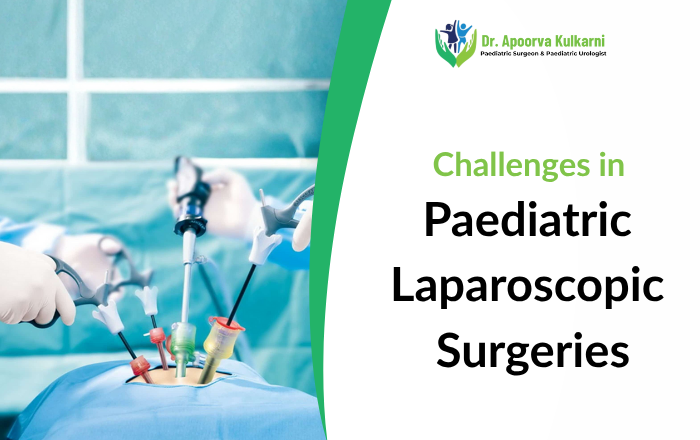
When your child needs surgery, it’s natural to feel worried and want the best possible care. Today, many children’s surgeries are performed using laparoscopic techniques—procedures done through small incisions rather than large cuts. This approach offers children faster healing, less pain, and smaller scars.
However, paediatric laparoscopic surgery comes with unique challenges that make it quite different from performing the same procedures on adults. Children’s bodies are smaller, their organs are still developing, and they respond differently to surgical stress. Let’s explore what makes these surgeries complex and why choosing an experienced paediatric surgeon matters so much for your child’s safety and recovery.
What Makes Paediatric Laparoscopic Surgery Different?
Children aren’t simply smaller versions of adults—their bodies work differently in many important ways. A paediatric laparoscopic surgeon must navigate several significant challenges that don’t exist when operating on grown-ups.
‣ Working in Very Small Spaces
Imagine trying to repair a watch while wearing thick gloves—that’s somewhat similar to operating inside a baby’s or young child’s abdomen. The working space is incredibly limited, and organs are much tinier. A surgeon’s instruments must move carefully around delicate structures without causing any damage. In infants, the entire abdominal cavity might be no larger than an adult’s palm, making every movement critical.
‣ Managing Anaesthesia in Young Patients
Children, especially babies and toddlers, respond very differently to anaesthesia medications compared to adults. Their small bodies can experience rapid changes in temperature, blood pressure, and breathing patterns during surgery. Maintaining stable vital signs throughout the procedure requires constant monitoring and quick adjustments. Even small shifts can have bigger impacts on younger patients.
‣ Limited Room for Surgical Instruments
During laparoscopic surgery, the abdomen is gently inflated with gas to create working space. In children, there’s much less room to position instruments at the right angles. Surgeons must work with restricted movement while maintaining a clear view through the camera. Too much gas pressure can affect a child’s breathing, so careful balance is essential throughout the operation.
‣ Age-Related Physical Responses
A newborn’s body behaves very differently than a five-year-old’s, and both differ greatly from a teenager’s. Younger children lose body heat faster during surgery, their fluid balance can shift rapidly, and their bodies metabolize medications at different rates. Surgeons must adjust their techniques based on the child’s specific age and developmental stage.
Technical Skill Requirements
Pediatric laparoscopic surgery challenges demand surgeons who have undergone special training beyond general surgery. It takes years to develop the hand-eye coordination and judgment needed to operate safely in such small spaces. Many procedures that are straightforward in adults become significantly more complex when performed on children, requiring both experience and steady hands.
‣ Specialized Equipment Needs
Standard surgical tools designed for adults are often too large for children’s bodies. Paediatric surgeons need smaller instruments, narrower cameras, and appropriately sized ports (the tubes through which instruments are inserted). Not all hospitals have access to this specialized equipment, which is why finding a surgeon who regularly performs these procedures on children is important.
Common Procedures and Conditions
Paediatric laparoscopic surgery treats various conditions in children, including:
- Appendicitis (inflamed appendix)
- Inguinal hernias (tissue bulging through the groin area)
- Undescended testicles
- Ovarian cysts
- Gallbladder problems
- Certain intestinal blockages
- Some congenital abnormalities
Each condition presents its own set of challenges, especially in younger patients.
How Skilled Surgeons Address These Challenges
Surgeons who specialize in children’s laparoscopic procedures overcome these obstacles through several approaches:
- Ongoing Training: They continually update their skills and learn new techniques specific to operating on children of different ages.
- Team Collaboration: They work closely with paediatric anaesthesiologists and nurses who understand children’s unique needs during and after surgery.
- Careful Planning: Before surgery, they thoroughly assess each child’s condition, considering age, size, and overall health to plan the safest approach.
- Appropriate Tools: They use instruments specifically designed for smaller patients and ensure their surgical facility is properly equipped.
- Family Communication: They take time to explain the procedure to parents and help prepare children in age-appropriate ways, reducing anxiety.
Recovery and What to Expect
Most children recover faster from laparoscopic surgery than traditional open surgery. Hospital stays are typically shorter—sometimes just one or two days for routine procedures. Pain is generally less severe, and children can often return to their normal activities within a couple of weeks.
Your child will have small incisions that heal with minimal scarring. Following your surgeon’s post-operative instructions carefully helps ensure smooth healing and the best possible outcome.
Frequently Asked Questions
1. Is laparoscopic surgery safe for infants and young children?
Yes, when done by trained pediatric surgeons in a well-equipped setup. Infants have smaller safety margins, so careful monitoring and gentle technique are key.
2. Why do some surgeries switch from laparoscopic to open?
Sometimes visibility is poor, or bleeding occurs. Switching to open surgery is a safety decision, not a failure.
3. Can all conditions in children be treated laparoscopically?
Not always. It depends on the child’s age, weight, and condition. Some very small or complex cases are still better handled through open surgery.
Making the Right Choice for Your Child
Understanding the complications of laparoscopic surgery in children and the skill required to prevent them helps you appreciate why surgeon selection matters. Your child’s surgery is not just about what needs to be done—it’s about who’s doing it and their experience with young patients.
Get Clear Answers Before Your Child’s Surgery — Book a Consultation Now
If your child needs laparoscopic surgery, Dr. Apoorva Kulkarni, a dedicated Pediatric Laparoscopic Surgeon in Thane, brings valuable experience in performing these delicate procedures on children of all ages. With focused training in paediatric surgery and a caring approach to working with young patients and their families, Dr. Kulkarni ensures each child receives thorough attention throughout their surgical journey.
Schedule a consultation with Dr. Apoorva Kulkarni in Thane to discuss your child’s surgical needs and learn more about the best treatment options available.
